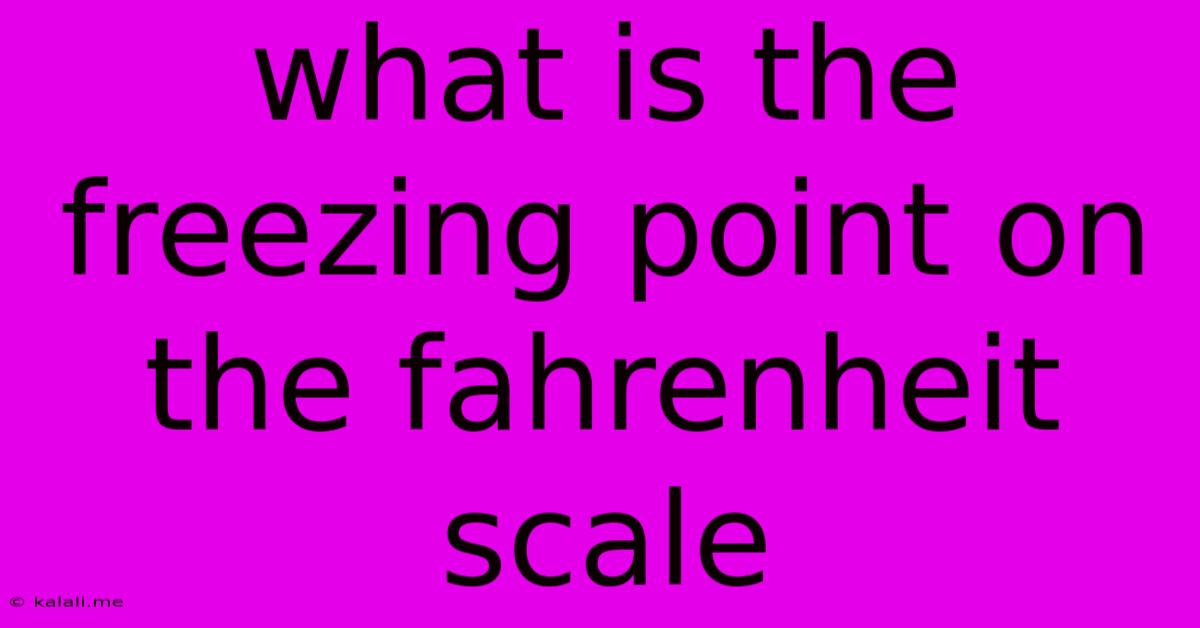What Is The Freezing Point On The Fahrenheit Scale
Kalali
Jun 12, 2025 · 3 min read

Table of Contents
What is the Freezing Point on the Fahrenheit Scale?
The freezing point of water on the Fahrenheit scale is 32 degrees Fahrenheit (°F). This is a fundamental point in understanding the Fahrenheit temperature scale, which is still used in the United States and a few other countries, alongside the more internationally prevalent Celsius scale. Understanding this simple fact is crucial for anyone working with temperature measurements or interpreting weather reports in regions that use Fahrenheit. This article will delve deeper into the Fahrenheit scale, its history, and why the freezing point of water is 32°F.
The History and Development of the Fahrenheit Scale
The Fahrenheit scale was developed by the German physicist Daniel Gabriel Fahrenheit in the early 18th century. Unlike the Celsius scale, which uses the freezing and boiling points of water as its defining points (0°C and 100°C respectively), Fahrenheit's scale was based on a different set of reference points. While the exact origins of his initial points are debated, one widely accepted version involves using a brine solution (water and salt) mixture as a zero point and human body temperature as another. This approach resulted in a scale where water's freezing point became 32 degrees and its boiling point 212 degrees.
Why 32°F? The Intriguing Origin
The specific choice of 32°F for the freezing point of water is not arbitrary, even though it might seem odd today. It's tied to Fahrenheit's initial zero point and the way he scaled his temperature readings. The lower reference point, close to the freezing point of a brine solution, and the division of the scale into specific increments, resulted in the value of 32 for water's freezing point. This is a testament to the scientific methods of the time and the development of practical scales for measuring temperature. It's important to note that there is some historical debate about the precise methods used by Fahrenheit.
Fahrenheit vs. Celsius: A Quick Comparison
For those more familiar with the Celsius scale, remembering that 0°C is the freezing point of water offers a convenient comparison point. The conversion between the two scales is straightforward, though not intuitive:
- °C = (°F - 32) × 5/9
- °F = (°C × 9/5) + 32
This simple formula helps anyone convert between Fahrenheit and Celsius, facilitating understanding and communication across different measurement systems. This is especially critical in scientific research or international collaboration.
Practical Applications of Knowing the Freezing Point in Fahrenheit
Knowing the freezing point of water on the Fahrenheit scale (32°F) has many practical implications, including:
- Weather forecasting: Understanding weather reports which use Fahrenheit.
- Cooking and baking: Many recipes, especially older ones, use Fahrenheit.
- Industrial processes: Industries using older equipment or legacy systems might still use Fahrenheit.
- General knowledge: It’s simply a useful piece of general scientific knowledge.
In conclusion, while the Celsius scale is increasingly dominant globally, understanding the Fahrenheit scale and its key reference point – the 32°F freezing point of water – remains essential for many practical applications and for comprehending historical scientific developments.
Latest Posts
Latest Posts
-
City College Of San Francisco Acceptance Rate
Jun 13, 2025
-
Average Gpa For Washington State University
Jun 13, 2025
-
How Many Chambers In A Frog Heart
Jun 13, 2025
-
What Is The Integral Of Xlnx
Jun 13, 2025
-
Drastic Times Call For Drastic Measures
Jun 13, 2025
Related Post
Thank you for visiting our website which covers about What Is The Freezing Point On The Fahrenheit Scale . We hope the information provided has been useful to you. Feel free to contact us if you have any questions or need further assistance. See you next time and don't miss to bookmark.